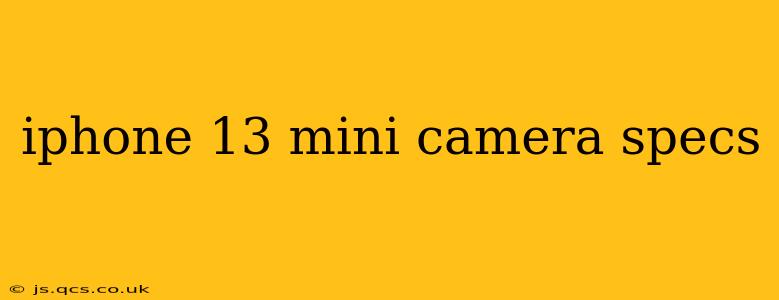The iPhone 13 mini, despite its compact size, packs a powerful photographic punch. Its dual-camera system offers impressive features and capabilities for a smartphone, exceeding many of its competitors in image quality and versatility. Let's delve into the specific camera specs and explore what makes this small phone a big photography powerhouse.
What are the main camera specs of the iPhone 13 mini?
The iPhone 13 mini boasts a dual-camera system featuring:
- Wide: 12MP, ƒ/1.6 aperture, Sensor-shift optical image stabilization (OIS)
- Ultra Wide: 12MP, ƒ/2.4 aperture, 120° field of view
These seemingly simple numbers translate to significant improvements in low-light performance and image clarity compared to its predecessor. The wider aperture on the main camera lets in more light, resulting in brighter and more detailed images, especially in challenging lighting conditions. The sensor-shift OIS further enhances stability, minimizing blur and producing sharper photos and videos. The ultra-wide camera provides a significantly broader perspective, perfect for capturing expansive landscapes or fitting more into a shot.
What is Sensor-shift optical image stabilization (OIS)?
Sensor-shift OIS is a significant advancement in image stabilization technology. Unlike traditional OIS, which moves the lens elements to compensate for camera shake, sensor-shift OIS moves the entire image sensor itself. This allows for more effective stabilization, particularly beneficial in low light where longer shutter speeds are often necessary. The result is noticeably sharper images and videos, even when shooting handheld in less-than-ideal conditions.
Does the iPhone 13 mini have a telephoto lens?
No, the iPhone 13 mini does not include a dedicated telephoto lens. Its photographic capabilities primarily rely on its wide and ultra-wide lenses. While it lacks the optical zoom capabilities of models with telephoto lenses, the image processing power and computational photography features of the iPhone 13 mini still allow for some level of digital zoom, though with a potential reduction in image quality at higher zoom levels.
How does the iPhone 13 mini's camera compare to other iPhones?
The iPhone 13 mini's camera system sits comfortably within the iPhone 13 lineup's capabilities. While it doesn't have the telephoto lens found in the iPhone 13 Pro and Pro Max models, its main and ultra-wide cameras offer comparable image quality and performance. The significant difference lies in the lack of advanced features like ProRAW and cinematic mode, which are exclusive to the Pro models. However, for the average user, the iPhone 13 mini’s camera is remarkably capable and delivers exceptional results.
What kind of video recording capabilities does the iPhone 13 mini offer?
The iPhone 13 mini can record video at up to 4K resolution at 60fps (frames per second) using both the wide and ultra-wide cameras. While it doesn't possess the cinematic mode found in the Pro models, which allows for shallow depth of field effects, it still offers excellent video recording capabilities with good stabilization and dynamic range. This makes it suitable for capturing high-quality videos for various purposes, from everyday memories to more professional-looking projects.
What are the low-light capabilities of the iPhone 13 mini's camera?
Thanks to its larger sensor and improved image processing, the iPhone 13 mini performs exceptionally well in low-light conditions. The ƒ/1.6 aperture on the wide lens allows for significantly improved light gathering capabilities compared to previous iPhone models. Combined with advanced computational photography features like Smart HDR 4, the phone produces brighter, cleaner images with reduced noise, even in challenging dark environments.
This detailed exploration of the iPhone 13 mini's camera specs provides a comprehensive understanding of its photographic abilities. While lacking some advanced features of its Pro counterparts, the iPhone 13 mini delivers a remarkably capable and versatile camera experience within a compact and portable package.
